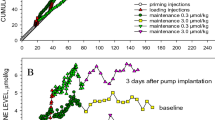Abstract
The effect of isradipine, a dihydropyridine calcium antagonist, on cocaine intravenous self-administration in rats was investigated. Administration of (±)isradipine (1.25–5 mg/kg SC) 2 h before the cocaine self-administration session induced a significant and dose-dependent increase in the number of coacine injections with respect to basal values. This effect was sterospecific, with the (+) form of isradipine being active, while the (−) stereoisomer was ineffective. These results suggest that isradipine antagonizes the rewarding properties of cocaine, possibly by inhibiting those dopaminergic systems related to reward mechanisms. These results further indicate a possible use of isradipine, or structurally similar compounds, in the treatment of cocaine related disorders.
Similar content being viewed by others
References
Calcagnetti DJ, Schechter MD (1992) Attenuation of drinking sweetened water following calcium channel blockade. Brain Res Bull 28:967–973
Carboni E, Imperato A, Perezzani L, Di Chiara G (1989) Amphetamine, cocaine, phencyclidine and nomiphensine increase extracellular dopamine concentrations preferentially in the nucleus accumbens of freely moving rats. Neuroscience 28:653–661
Chaudieu I, Alonso R, Mount H, Quirion R, Boksa P (1992) Effects of L- and N-type Ca2+ channel antagonists on excitatory amino acid-evoked dopamine release. Eur J Pharmacol 220:203–209
Di Chiara G, Imperato A (1988) Drugs abused by humans preferentially increased synaptic dopamine concentration in the mesolimbic system of freely moving rats. Proc Natl Acad Sci USA 85:5274–5278
Ettenberg A, Pettit HO, Bloom FE, Koob GF (1982) Heroin and cocaine intravenous self-administration in rats: mediation by separate neural system. Psychopharmacology 78:204–209
Ferry DR, Glossmann H (1982) Identification of putative calcium channel in skeletal muscle microsomes. FEBS Lett 148:331–337
Fratta W, Kuzmin A, Martellotta MC, Gessa GL (1991) The calcium antagonist isradipine inhibits cocaine and morphine reinforcing properties in rats. Soc Neurosci Abstr 17:887
Goll A, Ferry DR, Glossmann H (1983) Target size analysis of skeletal muscle Ca2+ channels. FEBS Lett 157:63–69
Griffiths RR, Bigelow GE, Henningfield JE (1980) Similarities in animal and human drug taking behavior. In: Mello NK (ed) Advances in substance abuse, vol. 1. JAI Press, Greenwich Connecticut, pp 1–90
Johanson CE, Fischman MW (1989) The pharmacology of cocaine related to its abuse. Pharmacol Rev 41:3–52
Kato T, Otsu Y, Furune Y, Yamamoto T (1992) Different effects of L-, N- and T-type calcium channel blockers on striatal dopamine release measured by microdialysis in freely moving rats. Neurochem Int 21:99–107
Koob GF (1992) Drug of abuse: anatomy, pharmacology and function of reward pathways. TIPS 13:177–184
Kuzmin A, Zvartau E, Gessa GL, Martellotta MC, Fratta W (1992) Calcium antagonists isradipine and nimodipine suppress cocaine and morphine intravenous self-administration in drugnaive mice. Pharmacol Biochem Behav 41:497–500
Lee HR, Roeske WR, Yamamura HI (1984) High affinity specific [3H](+)PN 200–110 binding to dihydropyridine receptors associated with calcium channels in rat cerebral cortex and heart. Life Sci 35:721–732
Le Moal M, Simon H (1991) Mesocorticolimbic dopaminergic network: functional and regulatory roles. Physiol Rev 71:155–234
Pani L, Carboni S, Kuzmin A, Gessa GL, Rossetti ZL (1990a) Nimodipine inhibits cocaine-induced dopamine release and motor stimulation. Eur J Pharmacol 176:245–246
Pani L, Kuzmin A, Diana M, De Montis G, Gessa GL, Rossetti ZL (1990b) Calcium antagonists differ in modifyng cocaine effects in the CNS. Eur J Pharmacol 190:217–221
Pani L, Kuzmin A, Martellotta MC, Gessa GL, Fratta W (1991) The calcium antagonist PN 200–110 inhibits the reinforcing properties of cocaine. Brain Res Bull 26:445–447
Supavilai P, Karobath M (1984) The interaction of [3H]PY 108–068 and of [3H]PN 200–110 with calcium channel binding sites in rat brain. J Neural Transm 60:149–167
Wise RW (1987) The role of reward pathways in the development of drug dependence. Pharmacol Ther 35:227–263
Author information
Authors and Affiliations
Rights and permissions
About this article
Cite this article
Martellotta, M.C., Kuzmin, A., Muglia, P. et al. Effects of the calcium antagonist isradipine on cocaine intravenous self-administration in rats. Psychopharmacology 113, 378–380 (1994). https://doi.org/10.1007/BF02245212
Received:
Revised:
Issue Date:
DOI: https://doi.org/10.1007/BF02245212




